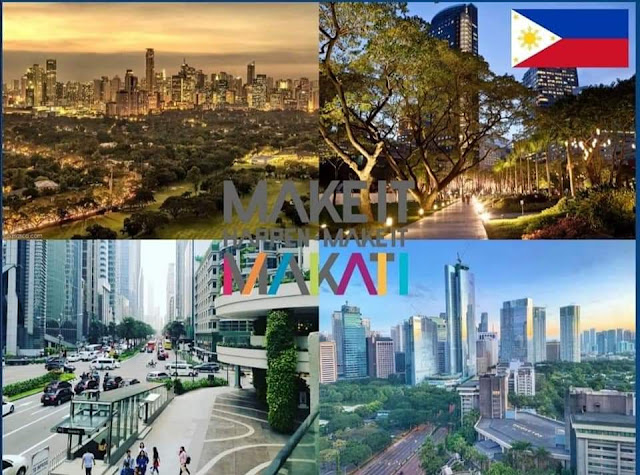, also known as the Makati CBD, is the leading financial and central business district in the Philippines located at the heart of
in Metro Manila.
In this guide, you will know about one of the biggest and richest Central Business Districts in Metro Manila.
ABOUT MAKATI CBD
Many of the skyscrapers in Metro Manila are in this area. The business district is also considered one of the most vibrant commercial districts in Southeast Asia. It contains the Ayala Center, one of the region’s major shopping centers.
The financial district is managed by two groups—the Makati Commercial Estates Association (MaCEA) and the Ayala Property Management Corporation (APMC).
Pre-war period
Downtown Makati started out as part of the wide municipality of Santa Ana de Sapa (part of the City of Manila today) and became a town of its own in 1670, then as San Pedro de Macati in honor of its patron, Saint Peter.
In 1851, Don José Bonifacio Roxas (a member of the Ayala-Roxas family) purchased the farm estate of “Hacienda San Pedro de Macati” from the Jesuits for 52,800 pesos. The western portion of the estate is now what is called the downtown. Since then, Makati and its development remain close to the Zobel de Ayala family.
In 1901, the Americans declared the whole area south of the Pasig River, including the whole Hacienda San Pedro de Macati (Downtown), down to Barangay Ayala Alabang, a US military reservation; thus establishing Fort McKinley, which is now known as Fort Bonifacio. That same year, the whole town, with a population of 25,000, was incorporated from the then Province of Manila to the new province of Rizal with Marcelino Magsaysay serving as the town president.
 |
| Nielson Field |
In the 1930s, the first airport in Luzon island, Nielson Field, opened in what is now the Ayala Triangle within the hacienda. The airport was officially inaugurated in 1938, and Philippine Airlines began its operations there in 1941.
Postwar period
The multiple-lane Ayala Avenue was completed in 1958, which was once part of the runway of the first commercial airport in the country, Nielson Airport. The downtown was developed into high density residential and commercial areas according to specific zoning regulations.
In the early 1960s, Ayala Corporation commissioned some of the first high-rise buildings along Ayala Avenue from one of the country’s best known architects, Leandro V. Locsin.
The Makati Stock Exchange (MkSE) was established on May 27, 1963, with its trading area located along Ayala Avenue in downtown. Although both the MSE (Manila Stock Exchange) and the MkSE traded the same stocks of the same companies, the bourses were separate stock exchanges for nearly 30 years until December 23, 1992, when both exchanges were unified to become the present-day Philippine Stock Exchange.
 |
| The Makati Commercial Center |
Martial Law era
 |
| Ayala Avenue in 1982 |
Following the assassination of Ninoy Aquino in 1983, the downtown area was one of the many places of rallies and mass demonstrations that were the basis of the People Power Revolution against the dictatorship of then-President Marcos in 1986. It was that decade that witnessed the emergence of a so-called moderate opposition, with the Makati Business Club, against Marcos’ ailing authoritarian regime.
1990s
The country’s first skyscrapers started to rise in the business district, including the Pacific Star Building, The Peak Tower, Pacific Plaza, and the Rufino Pacific Tower.
 |
| Rufino Pacific Tower |
Republic Act 7854, passed by Congress in late December 1994 and signed into law by President Fidel V. Ramos on January 2, 1995 officially established the City of Makati. On February 4, 1995, the character of the new city was ratified in a plebiscite with 91% of voters in favor of cityhood. The whole people of Makati especially the businessmen in downtown celebrated the remarkable event.
21st century
In 2003, The Oakwood mutiny took place in the Oakwood Premier (now Ascott Makati), within the Glorietta complex, and on 2007, the Manila Peninsula siege took place at The Peninsula Manila. Both happened at the Makati CBD to call for former president Gloria Macapagal Arroyo to step down.
The 2007 Glorietta explosion ripped through Glorietta 2 on October 19, 2007. The death toll in the explosion was 11, with 120 injured. Despite conflicting reports, it was concluded that the explosion was caused by a faulty liquefied petroleum gas tank located in a Chinese restaurant.
In 2011, the Occupy Wall Street movement protesting economic inequality and the power of United States financial institutions spread from New York City to other parts of the world, including the Philippines. The movement’s supporters’ first action was held on October 14, when protesters marched in Makati City from the Ninoy Aquino monument on Ayala Avenue to the American Chamber of Commerce. The movement here in the country is called “Occupy Philippines”, which had other protests held at the US Embassy and Rizal Park in Manila after the protest in Makati.
On 2014, the Makati Tourism Foundation and Makati city government started a tourism campaign called “Make it Happen, Make it Makati”, which promotes tourism mainly in the business district.
ATTRACTIONS TO SEE IN MANILA
Divisions
The Makati Central Business District is situated within four barangays of Makati.
Barangay Bel-Air
Barangay Bel-Air is an affluent enclave in the heart of Makati Central Business District, established in the early 1950s. It has a total land area of 1.7121 square kilometers (0.6610 sq mi), the third largest among the posh villages in Makati City.
The barangay includes Ayala North, Buendia Area, Ayala Triangle, Salcedo Village and Bel-Air Village. The predominant land use of this tobacco pipe-shaped barangay is residential and commercial. It boasts commercial buildings and establishments.
Bel-Air Village is the third subdivision developed by Ayala. The development, which started in 1957, was undertaken in four phases.
.jpg) |
| Bel-Air Village |
The village boundaries are clockwise, Estrella Street, EDSA, Jupiter Street, Nicanor Garcia (Reposo) Street, Kalayaan Avenue, Amapola Street, back to Estrella. The total land area of Bel-Air Village is 78.7242 hectares (194.532 acres), of which 64.6748 hectares (159.815 acres) is subdivided into 950 residential lots.
Ayala Triangle is a sub-district of Downtown Makati, comprising the land between Ayala Avenue, Makati Avenue and Paseo de Roxas. The Ayala Triangle Gardens is Makati’s Central Park, which was the only urban oasis in Makati at the heart of the central business district, will be developed into mixed commercial and residential space.
 |
| Ayala Triangle |
This triangular block also houses the Makati Stock Exchange, the Ayala Tower One and the Filipinas Heritage Library, built on the site of the historic Nielson Tower.
Salcedo Village is a business park developed by Ayala Corporation located in Makati Central Business District. It is named after the de Salcedo brothers – Juan and Felipe – who are both Spanish conquistadors who were part of the Legazpi’s expedition.
 |
| Salcedo Park |
It is bounded by Gil Puyat Avenue, Makati Avenue, Paseo de Roxas, and Ayala Avenue. It is home to the country’s notable office skyscrapers like the PBCom Tower and GT International Tower, as well as the Salcedo Community Market at Salcedo Park.
Ayala North is an informal district bounded by the streets of Gil Puyat Avenue, Ayala Avenue Extension, Metropolitan Avenue and Nicanor Garcia Street.
 |
| Alphaland Makati Place in Ayala North |
It is the home of Alphaland Makati Place, The Columns Ayala Avenue, Makati Life Medical Center, BIR Regional Office Building, The Zone Sports Center and FEU Campus Makati.
Buendia Area got its name from the former name of Gil Puyat Avenue. The offices of Department of Trade and Industry is located at 385 Industry and Investments Building along Buendia.
 |
| SM CyberTwo Building along Buendia Ave. |
SM Cyberzone Buildings and other mid-rise commercial buildings is found along Gil Puyat Avenue. Buendia MRT Station serves the area. It is one of the two underground stations that can be found on the transit, the other being is the Ayala MRT Station, which is also serves the business district.
Barangay San Antonio
Barangay San Antonio has a land area of 0.8958 square kilometers (0.3459 sq mi) which occupies 3.3% of the city’s total land area. San Antonio is bounded by Barangay La Paz in the north, Barangays Pio Del Pilar and San Lorenzo in the south, Barangays Sta. Cruz and Bel-Air in the east, and Barangay Palanan in the west. Formerly called Barrio Camachile, it is named after Saint Anthony of Padua, the barrio’s patron saint.
San Antonio Village is a medium density residential village in the northern portion of the barangay. Other recognized structures located there include the San Antonio National High School, San Antonio Elementary School, National Shrine of the Sacred Heart, and St. Paul the Apostle Sanctuary. Moreover, the most notable personality residing in the village is former Vice President Jejomar Binay and his family.
San Antonio South is an informal highly density residential and commercial area in the southern portion of the barangay. It is bounded by Metropolitan Avenue, Chino Roces Avenue, Ayala Avenue Extension, Yakal and Dela Rosa Streets.
 |
| Dela Rosa Street |
It consists of high-rise residential and commercial buildings, as well as the Makati Central Police Headquarters, Makati Central Fire Station, and Makati Central Post Office.
ACTIVITIES AND TOURS IN MANILA
Barangay San Lorenzo
Barangay San Lorenzo, included under Cluster 1 or Central Cluster, is considered one of the richest barangays in the Philippines for it embraces part of the Central Business District, where its revenue mainly comes from. It has a total land area of 1.7341 square kilometers (0.6695 sq mi).
The population density of Barangay San Lorenzo is computed to be 6 persons per 1,000 square meters. Established in the 1950s, it is also one of the oldest.
Ayala Center is a major commercial development operated by Ayala Land located in the central business district of Makati. It is a premier shopping and cultural district in Metro Manila.
 |
| Ayala Center along Ayala Ave. |
The area is bounded by Ayala Avenue on the east, Epifanio de los Santos Avenue (EDSA) on the south, Arnaiz Avenue on the west, and to north by Legazpi Street and Paseo de Roxas. The Ayala MRT Station of the MRT Line 3 serves the area. The development originally started with a number of separate shopping arcades and Greenbelt Park before expanding to cover over 50 hectares (120 acres). Glorietta and Greenbelt shopping malls are located within the complex. This lifestyle hub is the Philippines’s shopping mecca, and is serviced by upscale hotels.
Legazpi Village is a business park built by the Ayala Corporation within the Makati downtown area. It is named after Miguel López de Legazpi, a Spanish conquistador who became the Spanish East Indies’s (present-day Philippines) first Governor-General under the Spanish rule. The area is home to the Asian Institute of Management, as well as the Washington SyCip Park and Legazpi Active Park.
Pasong Tamo Area is an informal district located along Chino Roces Avenue (formerly Pasong Tamo) outside San Lorenzo Village. Don Bosco Makati, The Beacon Makati, Cityland Pasong Tamo Tower, Makati Ford, Wilcon IT Hub, San Lorenzo Place, and some warehouses are located in this area.
San Lorenzo Village is a residential village located at the south of Legazpi Village and Ayala Center. It is the home of Assumption College San Lorenzo.
Barangay Urdaneta
The smallest barangay to complete Central Cluster is Barangay Urdaneta with a total land area of 0.7399 square kilometers (0.2857 sq mi). It is one of the first centrally planned communities together with Forbes Park, San Lorenzo and Bel-Air which was established in the 1950s by the Ayala Family.
Originally, Urdaneta and Bel-Air formed part of a single village called “Beldaneta”. The barangay is bounded by the roads of EDSA, Ayala Avenue, Makati Avenue, and Buendia Avenue. Its bounding barangays are Bel-Air (north and west), San Lorenzo (south), and Forbes Park (east).
Roxas Triangle is a district and intersection of the major streets of Paseo de Roxas, Makati Avenue and Gil Puyat Avenue. The offices of Development Bank of the Philippines and Metropolitan Bank and Trust Company are located here. Mandarin Oriental Manila and Roxas Triangle Towers are also located in the area.
Apartment Ridge is a complex of apartment and condominium buildings along the streets of Makati Avenue and Ayala Avenue outside Urdaneta Village. The Peninsula Manila, Discovery Primea and The Makati Tuscany are located in this area.
Urdaneta Village is a quiet and peaceful residential gated community within in its barangay. The name of the barangay came from the subdivision’s name.
The next nearest airport is the Clark International Airport.





